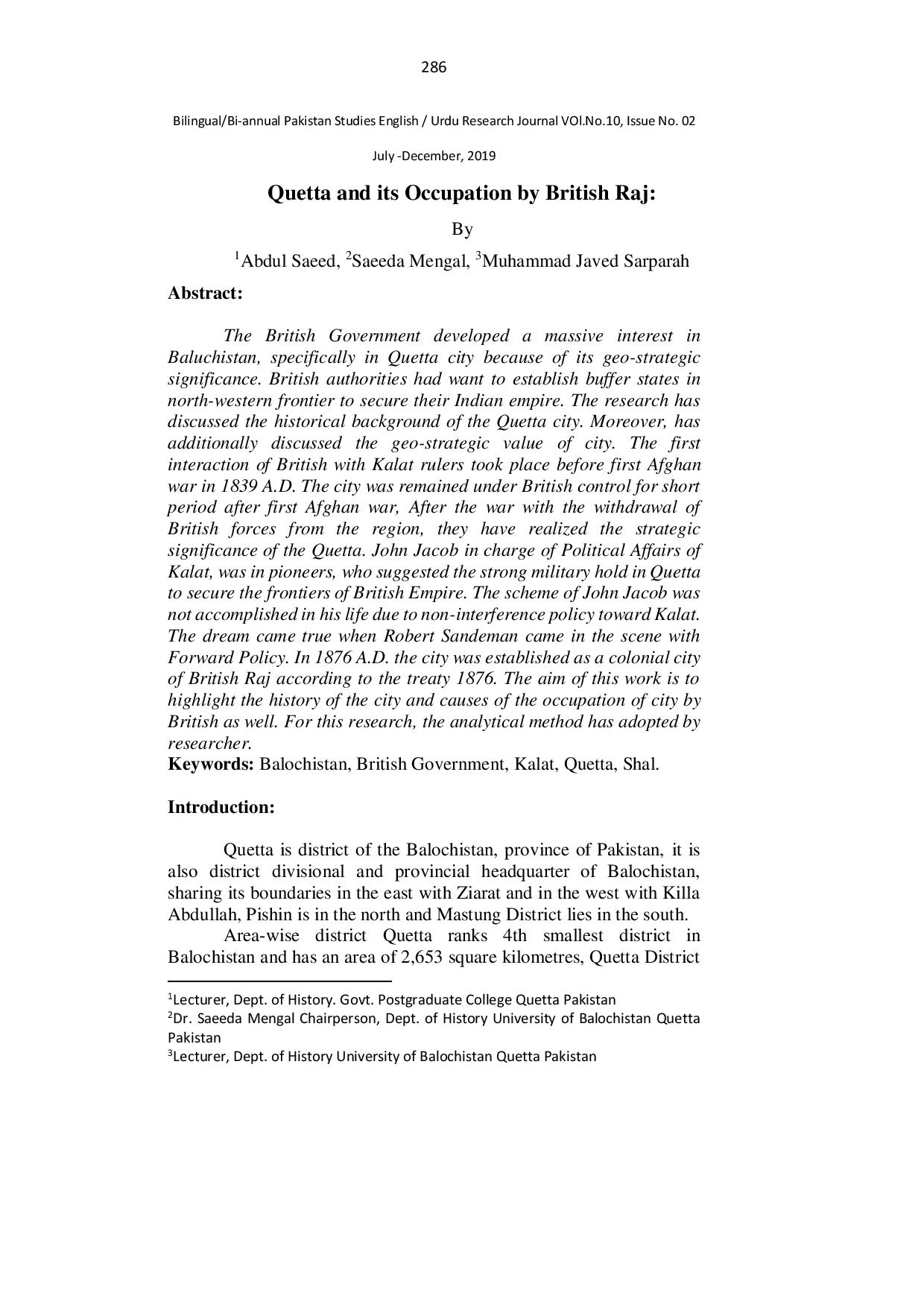Quetta and its Occupation by British Raj
Keywords:
Balochistan, British Government, Kalat, Quetta, Shal.Abstract
The British Government developed a massive interest in
Baluchistan, specifically in Quetta city because of its geo-strategic
significance. British authorities had want to establish buffer states in
north-western frontier to secure their Indian empire. The research has
discussed the historical background of the Quetta city. Moreover, has
additionally discussed the geo-strategic value of city. The first
interaction of British with Kalat rulers took place before first Afghan
war in 1839 A.D. The city was remained under British control for short
period after first Afghan war, After the war with the withdrawal of
British forces from the region, they have realized the strategic
significance of the Quetta. John Jacob in charge of Political Affairs of
Kalat, was in pioneers, who suggested the strong military hold in Quetta
to secure the frontiers of British Empire. The scheme of John Jacob was
not accomplished in his life due to non-interference policy toward Kalat.
The dream came true when Robert Sandeman came in the scene with
Forward Policy. In 1876 A.D. the city was established as a colonial city
of British Raj according to the treaty 1876. The aim of this work is to
highlight the history of the city and causes of the occupation of city by
British as well. For this research, the analytical method has adopted by
researcher.
References
Ahmed, K. u. (2015 2nd Edition ). In Sahafat Wad-e-Bolan Main.
Quetta : Balochi Academy.
Aitchison, C. U. (1909). In A Collection of Treaties, Engagements, and
Sanads vol. XI. Calcutta: Superintendent Government Printing.
Awan, A. B. (1985). In Baluchistan: Historical and Political
Processes. London: New Century Publishers.
Baloch, I. (1987). In The Problem of Greater Baluchistan: A Study of
Baluch nationalism. Stuttgart: Steiner Verlag Wiesbaden
GMBH.
Breseeg, T. M. (2004). In Baloch Nationalism: Its Origin and
Development. Karachi: Royal Book Company.
Bruce, R. I. (1900). In The Forward Policy and it Results. London:
Longmans, Green, and Co. .
Buller, R. H. (1907). In Baluchistan District Gazetteer Series.
QUETTA-PISHIN DISTRICT. Ajmer: Scottish Mission
Industries Co.. Ltd.
Buller, R. H. (1908). In IMPERIAL GAZETEER OF INDIA Provincial
Sereies Baluchistan. Calcutta: Suprintendent of Government
Printing.
Dashti, N. (2012). In The Baloch and Balochistan A historical account
from the Beginning to the fall of the Baloch State. USA:
Trafford Publishing.
(2011). District Development Profile Quetta. Quetta: Planning &
Development Government of Balochistan.
Durand, H. M. (1879). In The First Afghan War and its Causes.
London: Longmans' Green'and Co.
Duthie, J. L. (1979). Failure and success: John Jacob's Quetta project
–76. Asian Affairs, 10:3, DOI:
1080/03068377908729951, 272-291.
Gichki, D. N. (2015). In Baloch: in Search of Identity. London:
Wrigley's.
Habibi, A. H. (1962). Shaal and Bolan. Kandahar Magazine Number
, 25.
Hughes, A. W. (2002). In The Country Of Balochistan. Quetta: Sales &
Services Jinnah Road.
Marri, J. M. (1985). In Search Lights on Baloches and Balochistan.
Quetta: Gosha-e-Adab.
Ram, L. H. (2017 10th edition ). In Tareekh Balochistan. Quetta :
Sales & Services.
Swidler, N. (2014). In Remotely Colonial: History and Politics in
Balochistan. Karachi: Oxford University Press.
Thorton, T. H. (2017 Edition). In Colonel Sir Robert Sandeman His
Life and work. London : Wrigley's.
Tucker, A. L. (1921). In Sir Robert G. Sandeman: Peaceful Conquror
of Baluchistan. London: The Macmillan Company.



